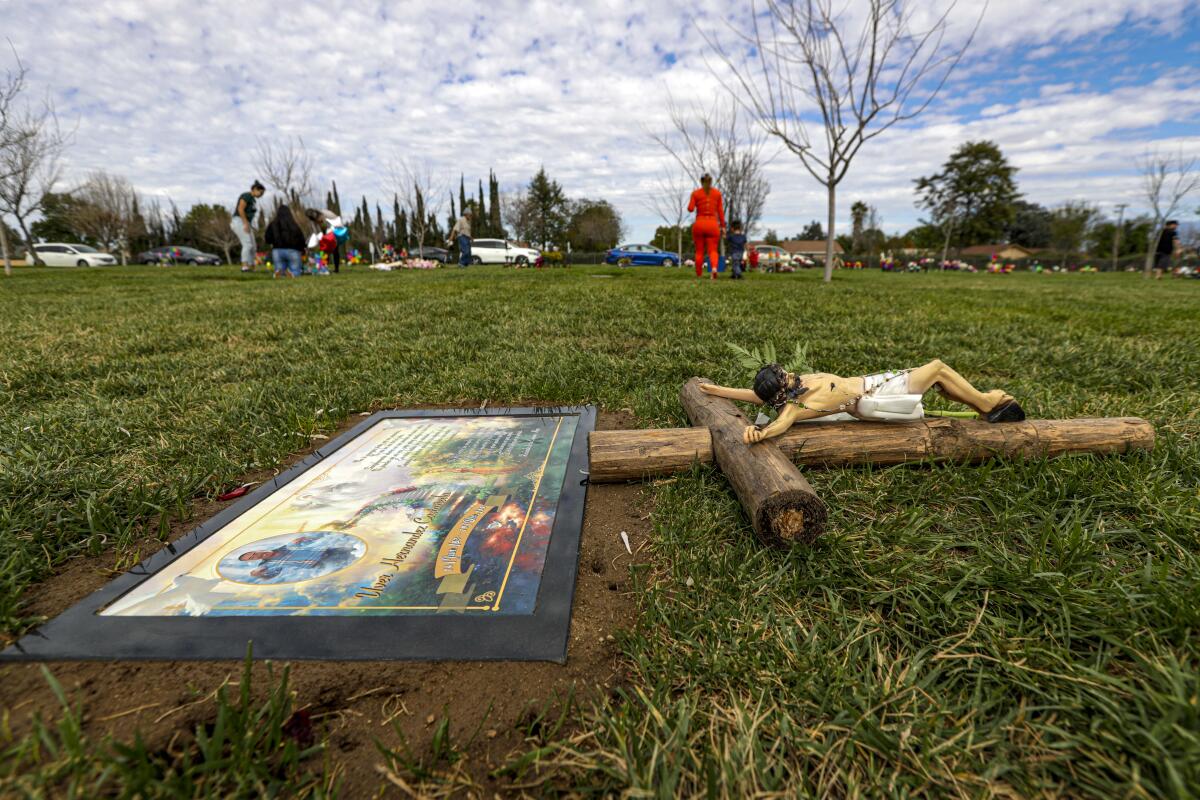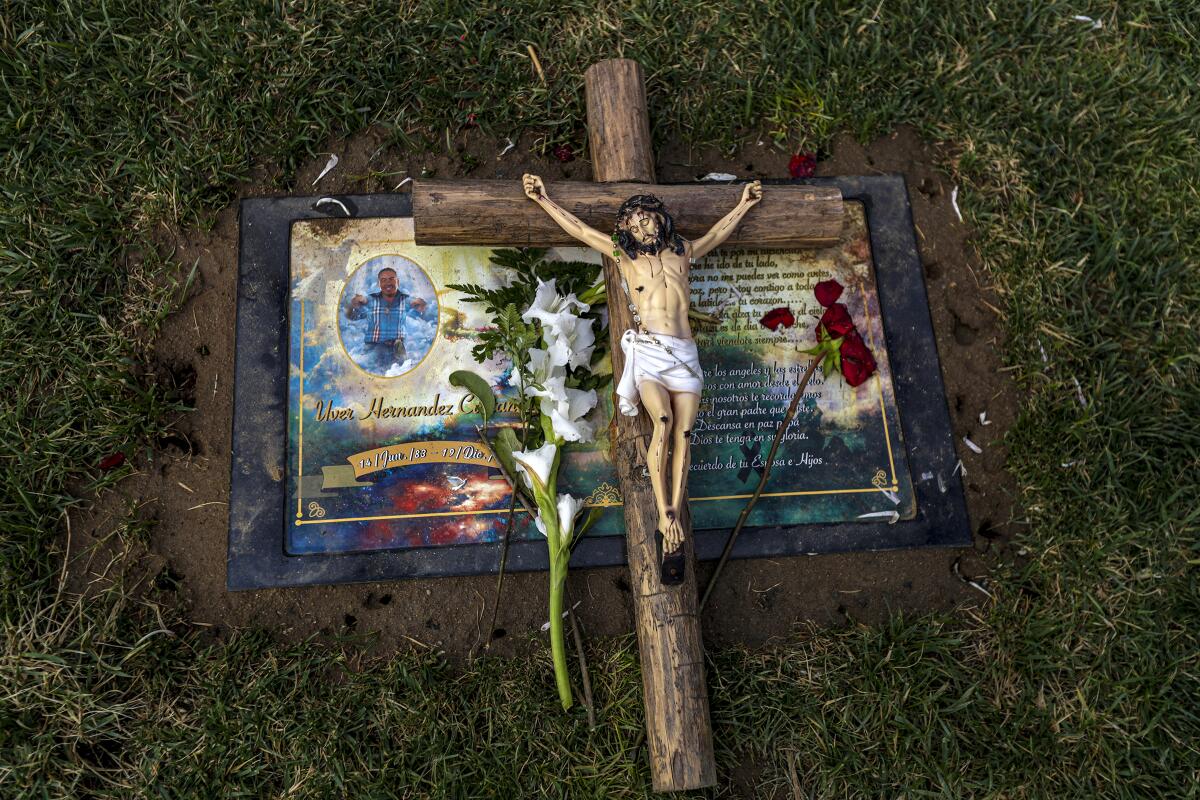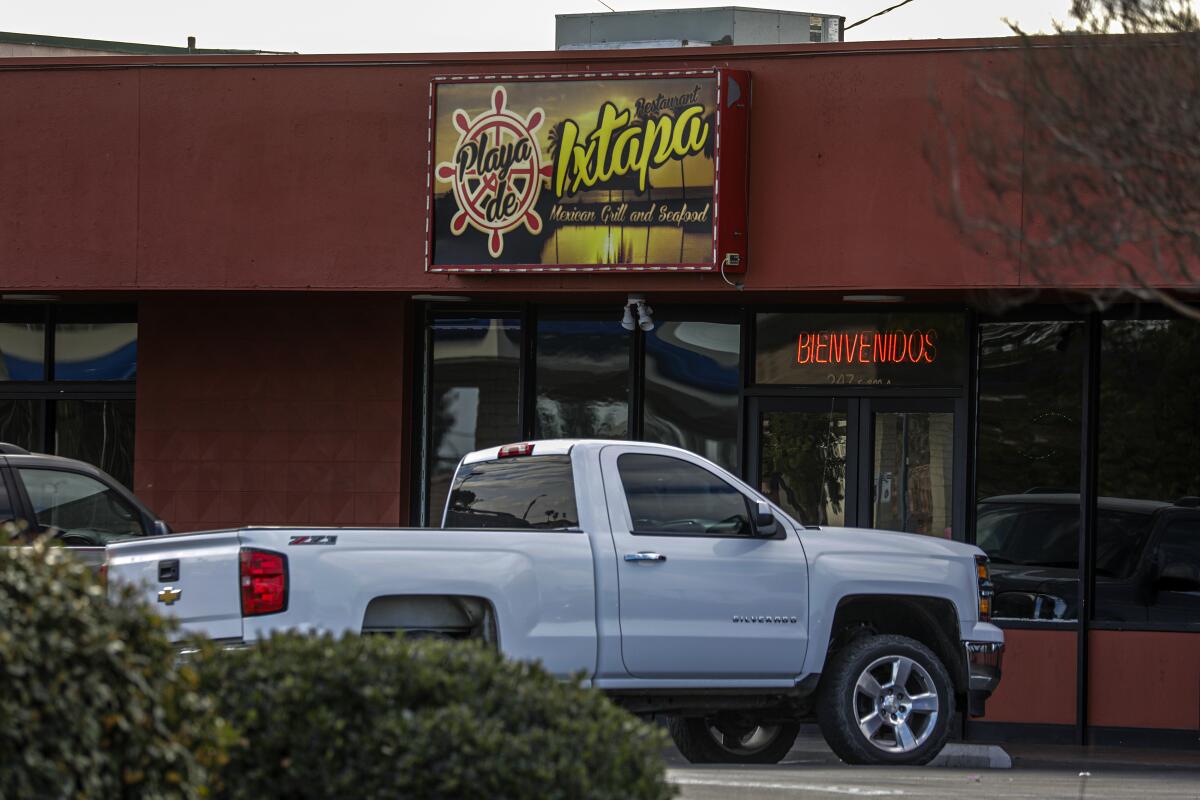Mystery over cemetery slayings sparks fear and rumors in California town

- Share via
On a brisk Sunday evening, four men shared food and drinks before stumbling the next morning into a humble little cemetery dotted with leafless trees.
They came to pay their respects to an old friend, Uver Hernandez Castañeda.
Only one of the men would walk out of Perris Valley Cemetery.
Near the grave of Hernandez Castañeda lay the bodies of three of the men. The fourth became the subject of a manhunt.
On Thursday, ten days after the slayings, law enforcement in Cheyenne, Wyoming arrested Jose Luis Torres Garcia after a traffic stop of a 2007 silver GMC. Riverside County sheriff officials said 15 pounds of marijuana was recovered from the suspect’s vehicle.
Detectives say the 33-year-old Torres Garcia killed Jaime Covarrubias Espindola, 50; Jose Maria Aguilar-Espejel, 38; and Rodrigo Aguilar-Espejel, 28.
The triple killing Feb. 17 in this Riverside County town of nearly 78,000 people caused a ripple of fear after the sheriff invoked the specter of cartel involvement.
Sheriff Chad Bianco was attempting to quell residents’ concerns at a news conference, saying they should not feel in danger and that the killings were not related to several others in the county. On Feb. 2, a man was shot at an Arco gas station across from Perris’ Mariscos Playa de Ixtapa restaurant, and 10 days later, a man was killed at a nearby park. (A couple of days after the cemetery killings, three women were found dead in pools of blood inside a home in nearby Hemet.)
“We’re receiving some of the same information that you are, that it’s gang related, that it’s cartel related,” Bianco said. “We’re looking into all of that.”
The sheriff didn’t answer questions about how the men were killed, whether a weapon was used or how they were found. Autopsies were completed Monday, but coroner officials referred questions to homicide investigators. The investigator on the case, Alberto Loureiro, declined to speak to a Los Angeles Times reporter about the details.
Asked during the news conference if the men were killed “execution-style,” Sheriff Bianco said: “You could get into semantics of what you would call it, but it certainly seems that way.”
No motive has been established for the killings. But that hasn’t stopped rumors from flowing in town.
The grave the men had been visiting belonged to a man who met a violent end just months before, more than 1,700 miles away in central Mexico. Hernandez Castañeda had been tortured and murdered near the highlands of Opopeo, in the state of Michoacán, while on his way to visit family for the holidays.
On Dec. 18, he was driving a white Range Rover to his family’s home in Turicato, Michoacán, a town dominated by a strong cartel presence, according to Mexican news reports.
He never made it. On Dec. 20, his family reported him missing, and two days later, his body was found with gunshot wounds and other “signs of violence” near Opopeo, a pueblo of less than 9,000 people where locals have formed self-defense teams against drug traffickers.
On social media and at the cemetery, family and friends insisted he had no enemies. He was remembered as a kind, giving father and husband who had inadvertently become entangled in the violence convulsing parts of Mexico.
On a recent morning, a crowd of curious cemetery visitors gathered to take a peek at the grave of Hernandez Castañeda. Suddenly, a white Nissan SUV drove into the cemetery. A man in a black T-shirt and a woman dressed all in orange exited the vehicle with their young son and walked toward Hernandez Castañeda’s grave. Seeing the family approach, the small group scattered.

The woman identified herself as the sister-in-law of Hernandez Castañeda. According to her, the man had lived in the U.S. for 20 years with his family. But he had a lover, she said.
Hernandez Castañeda’s sister-in-law said the woman apparently had a powerful lover in Mexico. When Hernandez Castañeda made the holiday trip to his home country, he was killed, his sister-in-law said. Like many others interviewed by The Times, she declined to allow her name to be used, citing concerns about her safety.
“There’s no justice in Mexico,” she said, shaking her head as she looked down at her brother-in-law’s headstone.
By the time the family visited Hernandez Castañeda’s grave, it had been cleaned of any signs that something horrible had happened there in recent days. Under a beaming sun, a wooden crucifix lay over his flat headstone, partially hiding an engraving: “Don’t be saddened by my absence, I haven’t left your side … You can’t hear my voice, but I’m still with you.”
Earlier that morning, the sound of crows squawking and doves cooing in the early morning was slowly replaced by chatter and cumbia music as families settled in to spend time with deceased loved ones, laying folding chairs, blankets and snacks on the green grass feet away from Hernandez Castañeda’s grave.

One woman, who only gave her name as Victoria, ventured across the cemetery to visit Hernandez Castañeda’s headstone. She was merely curious. But she turned around before getting too close. Suddenly, she worried about whether the wrong person might be watching.
“It’s better to say you don’t hear anything, because people could be watching,” the woman said. “It’s better to observe from a distance.”
A cemetery employee and his friend — who both asked to remain nameless — nervously tiptoed around the idea that the triple killing might be cartel-related.
“I don’t want to know a thing about that,” the employee said.
The town of Perris is a hot spot for tourists who visit Perris Lake and enjoy adventures like skydiving and hot air balloon rides. The “skydiving capital of America” rarely makes news — except when skydiving tragedies occur.
It’s a family-oriented town that has appealed to locals for its calmness and safety. More than 75% of the population is Latino.
Olivia Moreno de Gonzalez, who identified herself in a phone interview as the owner of Mariscos Playa de Ixtapa, said she had been busy fending off rumors, including that Hernandez Castañeda was the owner, rather than an employee. One of the victims of the cemetery killings, Covarrubias Espindola, was also an employee, she said.
“Many things people are saying are lies, and it’s affecting us,” Moreno de Gonzalez said. “Honestly, we’re the same as you. We don’t know anything.”

At a local swap meet, a woman selling religious memorabilia said she remembered two men who showed up looking for candles and a prayer book for their cousin. They told her he had been killed in Mexico. She recognized a crucifix she sold as one that ended up on Hernandez Castañeda’s headstone. But the woman said she could not remember who purchased it.
Back in the cemetery, Hernandez Castañeda’s brother knelt in front of the grave and removed the crucifix and two flowers that had been lying there. He wiped the headstone somberly. His brother, he said, was not involved in any cartel activity, despite his slaying and the strange one that befell three men at his plot.
“Everyone who knows us knows it’s not what people are thinking,” he said.
The morning of the killings, the man said he got a call from a family friend.
“I see three men sleeping on your brother’s grave,” she told Hernandez Castañeda’s brother.
“I’ll be right there and I’ll see who they are,” he said. But before he could, she called again.
“I think they’re dead,” she said.

He raced to his brother’s grave to investigate for himself, but by then the cemetery was swarmed with sheriff’s deputies and investigators.
Hernandez Castañeda’s brother said he had a far simpler theory about the tragic event: The four men were drinking and got into a fight. It wasn’t unusual for his brother’s friends to visit his grave. He had told them repeatedly not to bring bottles to the cemetery, since drinking is forbidden on the grounds.
He was familiar with the four men, the brother said. One of them, Covarrubias Espindola, was a beloved chef at the Mariscos Playa de Ixtapa restaurant, who would leave his kitchen to ask guests whether they enjoyed his food and take personal dish requests from friends.
The other men he knew only as his brother’s friends. Nothing about the suspect, Torres Garcia, struck him as concerning.
“I don’t know this crazy mentality he had,” the brother of Hernandez Castañeda said.
He heard that one of the bodies lay to the right of his brother’s tombstone; the other two, to the left.
Other than that, he said, it’s all a mystery.
More to Read
Sign up for Essential California
The most important California stories and recommendations in your inbox every morning.
You may occasionally receive promotional content from the Los Angeles Times.











